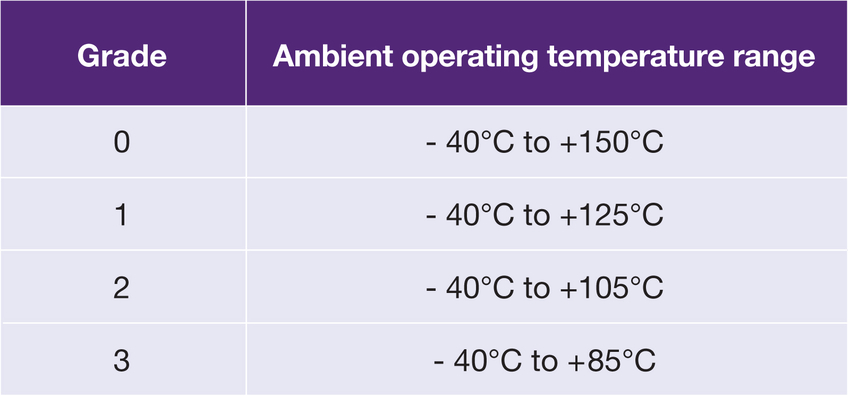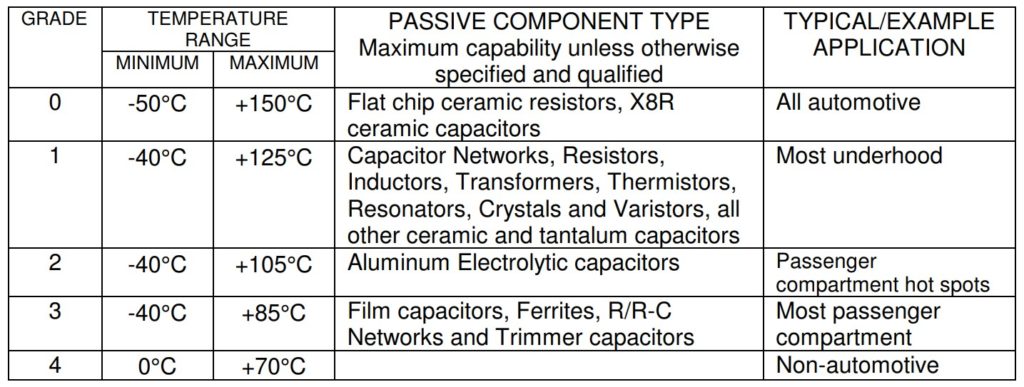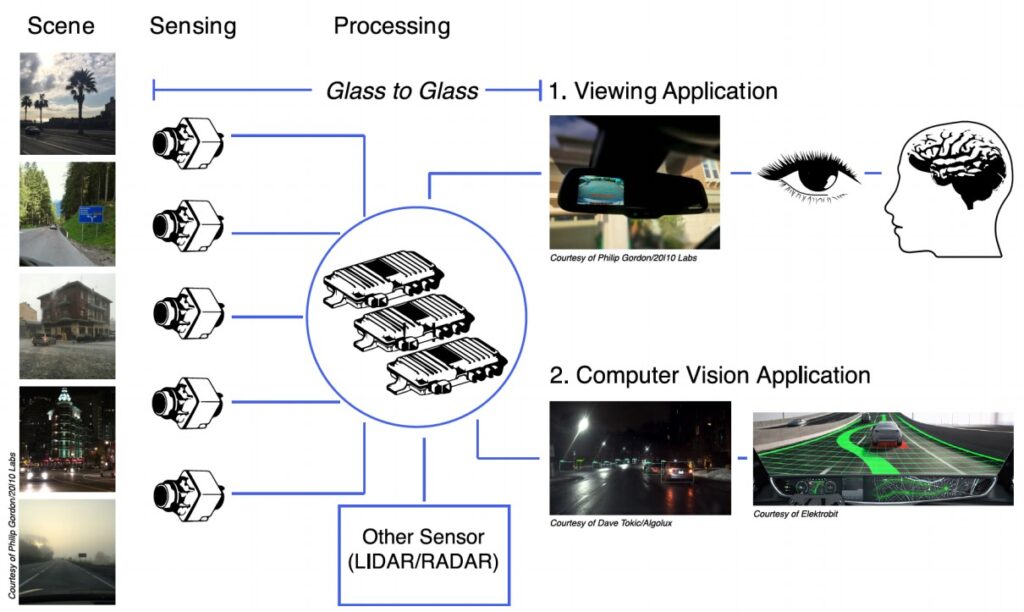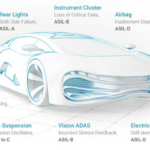Automotive qualification means that a component or system meets specific industry standards for manufacturing and performance. Automotive qualification is not a static landscape. New standards are developed in response to new technologies, and existing standards evolve in response to changing applications and new mission profiles. This FAQ reviews and contrasts key international automotive standards such as IATF 16949, AEC-Q100, and AEC-Q200. It looks at how those standards are expanding to cover new technologies such as LIDAR. And it looks into emerging standards such as the IEEE-SA P2020, a working group for automotive imaging standards.
The AEC-Qxxx documents from the Automotive Electronics Council are generic and not expected to cover all use scenarios and all possible failure modes of electronic components. Specific stress conditions are tailored to cover a single failure mode for one specific mission profile or use case. For example, in AEC-Q100, for grade 2 semiconductor components, high-temperature operating life (HTOL) testing of 1000 hours at a temperature of 125°C is required. Those test conditions are derived from specific assumptions about the mission profile and a specific reliability model:
- Mission profile: 12000 hours at an average junction temperature of 87°C
- Reliability model: Failure mode acceleration with temperature based on the Arrhenius equation with activation energy of 0.7eV.
The stress conditions and durations included in AEC-Q100 may need to be modified for new semiconductor or packaging technologies with significantly different thermal performance. If the activation energies for failure are significantly lower, the 1000 hours HTOL testing may not be adequate. It could be that a mission profile considering a single average temperature does not reflect real operating conditions. And the HTOL duration may need to be modified based on specific temperature spectrums for a given activation energy assumption and mission profile. Finally, the emergence of new device technologies such as LED lighting or solid-state lasers can demand new testing regimes. The three most-cited AEC-Qxxx standards are:
- AEC-Q100: Failure Mechanism Based Stress Test Qualification for Integrated Circuits
- AEC-Q101: Failure Mechanism Based Stress Test Qualification for Discrete Semiconductors
- AEC-Q200: Stress Test Qualification for Passive Components
While these three standards are the most commonly cited, the “Documents” page on the AEC website lists 37 standards and sub-standards, with seven listed as either “new” or in “initial release.” It’s a dynamic landscape, and it’s expected to remain that way as new technologies such as Advanced Driver Assistance Systems (ADAS) and automated driving are rolled out.
Various flavors of AEC-Q10x
AEC-Q100 and AEC-Q101 are the most-cited automotive quality specifications for semiconductor devices. ISO/TS-16949 is often considered a companion standard for the AEC-Qxxx specifications. It is an international technical specification for Automotive Quality Systems. It was defined to establish common part-qualification and quality-system standards. It contains detailed qualification and requalification requirements and unique test methods and guidelines for using generic data.
AEC-Q100 and AEC-Q102 are based on IEC and JEDEC specifications that have been extended for automotive applications. The AEC-Q100 outlines the stress tests and reference test conditions for the qualification of automotive-grade integrated circuits, while AEC-Q101 focuses on discrete semiconductor devices. They define four grades based on operating temperature ranges that extend beyond the 0°C to 70°C that is typically used for consumer-grade devices.

In addition, focused standards have been developed for optoelectronics, sensors, and multichip modules:
- AEC-Q102: Failure Mechanism Based Stress Test Qualification for Discrete Optoelectronic Semiconductors in Automotive Applications
- AEC-Q103: Failure Mechanism Based Stress Test Qualification for Sensors in Automotive Applications
- AEC-Q104: Failure Mechanism Based Stress Test Qualification for Multichip Modules (MCM) In Automotive Applications
These focused standards continue to evolve as new technologies and applications are developed. For example, initially focused on photodiodes, AEC-Q102 was revised in 2016 to add LEDs for all exterior and interior automotive lighting applications. It was revised again in April 2020 to add solid-state lasers for LIDAR systems. It defines the minimum stress test-driven qualification requirements and references test conditions for the qualification of optoelectronic semiconductors. It combines state-of-the-art qualification testing, documented in various documents (e.g., JEDEC, IEC, MIL-STD) and manufacturer qualification standards.
In the case of LEDs, the useful lifetime required is strongly dependent on the application. Interior lighting has less stringent requirements compared with exterior applications. In addition, applications for trucks can have different requirements compared with automobiles.

The qualification of multichip modules using optoelectronic functions and other components (e.g., LEDs with integrated circuits, laser components with photodiodes, optocouplers, etc.) is described in a separate document AEC-Q102-003.
AEC-Q200 for passives
An AEC-Q200 qualified passive device has passed the environmental stress testing requirements of the AEC-Q200 global standard. The procedures set out in this standard test the ability of passive electronic components to withstand the temperature and physical stresses of automotive environments. Automotive industry companies require the use of AEC-Q200 qualified components. Stress test qualification temperature ranges established by the AEC-Q200 standard are categorized into five grades (0 – 4).

As seen above, there are specific standards for various types of passive components. In AEC-Q200, Table 5 defines the test methods and additional requirements for magnetics, including inductors and transformers. These tests include a variety of methods to test the component’s ability to withstand severe conditions, including:
- High temperature
- Thermal cycling
- Thermal shock
- Low-temperature storage
- Moisture and humidity resistance
- 1000 hours at rated temperature and current
- Mechanical shock and vibration
- Constant acceleration
- Resistance to soldering heat
- Resistance to cleaning solvents
- Terminal force strength
- Shear strength
- Board flex
Component samples must be measured for all the passive devices covered by IEC-Q200 to verify that physical dimensions coincide with the datasheet description. They are inspected visually for construction, marking, and workmanship. Finally, the electrical parameters are measured pre- and post-stress testing to verify conformity to specifications.
IEEE standard for automotive system image quality
The IEEE-SA P2020 working group on automotive imaging standards was established to address the considerable ambiguity in measuring the image quality of automotive imaging systems, both human and computer vision-based. The goal is to specify methods and metrics for measuring and testing image quality in automotive systems to provide consistency and create common performance reference points.
It is being developed to address the fundamental image attributes and quality needed for ADAS applications and identify existing metrics and other useful information relating to these attributes. It also defines subjective and objective test methods for measuring automotive camera image quality attributes and specifies tools and test methods. Image quality is important in ADAS implementations for both automotive viewing by drivers (human machine interfaces or HMIs) and automotive computer vision systems.

For viewing-based, HMI camera systems, the output of the image has conflicting requirements. On the one hand, it has to be visually appealing and “pleasant” and provide a high quality of experience or high level of satisfaction to the user. At the same time, it needs to efficiently and effectively communicate the detailed information required for the application (such as visible detail in shadowed areas). Pleasantness and usefulness do not necessarily correlate, and balancing the two can be challenging.
Computer vision systems interpret useful information differently from human operators. For computer-vision-based systems, the technical analysis does not include pleasantness. Still, it focuses on various hardware components (lens, image sensor, image signal processor, lighting, and so on), and their parameterization to define image quality and optimize it for the needs of the specific mission or function. And the primary interest in computer vision systems is not always the visible spectrum.
HMIs and computer vision systems are integral to many infotainment, ADAS, and automated driving functions. Images can be the primary input for some applications to enable the driver or automated control system to recognize and react to the environment correctly. For that reason, the IEEE P2020 working group is focused on developing meaningful key performance indicators (KPIs) that can be used to quantify and describe the performance and limits of a camera system used in various applications.
Summary
Automotive qualification is a diverse and dynamic area. Existing standards are under constant review to determine if they still fit the needs of the latest technologies and mission profiles. New standards are being developed to address the needs of new applications such as ADAS, automated driving, computer vision, and LIDAR. “AEC-Q qualified” is an important factor in hardware procurement and system design, and it includes numerous “grades” and other dimensions.
References
A Guide to AEC-Q200 Qualified Components, Coilcraft
AEC Documents, Automotive Electronics Council
AEC-Q102 LED Qualification Review, Hella
Failure mechanism based stress test qualification for optoelectronic semiconductors in automotive applications, Automotive Electronics Council
IEEE P2020- Automotive Image Quality Working Group, IEEE






Leave a Reply